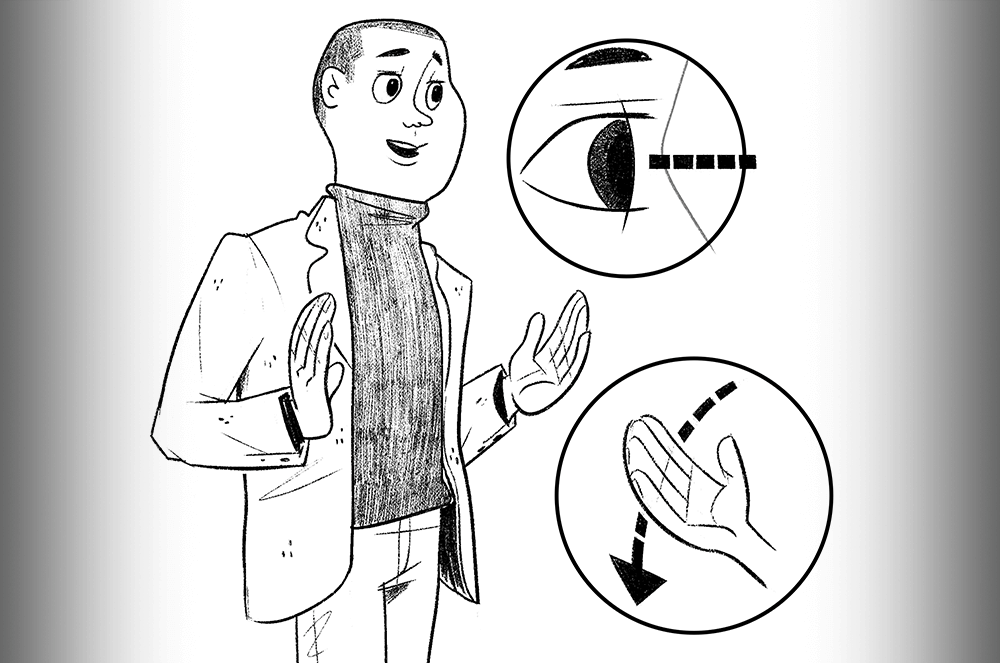
Henry, a fictional CEO of a mid-size software company, needs his team to generate creative ideas for a new project. At the team meeting, he sits behind a large desk. His mouth is set in a tight line, his shoulders slightly hunched, and his arms are crossed in front of him. In a flat tone, he says, “Okay, everyone, I want you all to feel free to float your ideas to the group.”
Compare Henry with Eleanor, a CEO of a different fictional software company. She also needs her team to brainstorm. As each team member enters the room, she smiles warmly and thanks them for coming. She is standing straight with her shoulders slightly back. Her palms are open as she welcomes people. In a confident tone, she invites her team to brainstorm their ideas.
Which CEO’s team is more likely to come up with the big idea that transforms the company?
While the examples are exaggerated, it’s clear that team Eleanor will win. Other factors being equal, Eleanor’s nonverbal behavior bespeaks a leader who is self-assured, open-minded, and likely to succeed.
As a speaker, your body communicates as much as your words. Your facial expression, vocal tone and inflection, posture, gestures, and even attire have a powerful effect on your audience. Body language, also known as nonverbal communication, is a key element of impression management at work because people form snap judgments of your personality and professionalism based on the nonverbal cues they perceive.
Where Do Body Language Habits Come From?
Nonverbal communication has three primary sources. First is instinct. Facial expressions like smiling, grimacing, and crying are universal. Even toddlers understand them. You can greet an audience from any culture with a smile and they will know you wish them well (as long as the smile is sincere).
The second source of nonverbal behavior is the repetition of actions you have seen in the past. Deborah Shames and David Booth, cofounders of presentation and communication training company Eloqui, note that you might have been told to put your hands behind your back or you unthinkingly imitate a beloved teacher who always counted on his fingers as he taught. Whatever the source, once you have internalized other people’s ideas about appropriate gestures, you tend to mimic them.
A third source of nonverbal communication derives from unresolved emotional issues. Perhaps you want to look happy and relaxed, but deep inside, you feel anxious and sad. You can only fake it for so long before people begin to get a sense of the person behind the mask. Until you resolve the internal issues that drive your body language, you might find it challenging to bring your nonverbal cues up to your desired level.
“You can have the most beautifully written speech, but if your body language doesn’t sync, it’s all for nothing.”
—Eden GillottGiven the strong impulses that drive nonverbal communication, how can you unlearn body language patterns that no longer serve you? Shames recommends that you videotape yourself giving a presentation and watch the video. You might be amazed to see that you are flapping your arms like a bird or staring down at the floor when you thought you were speaking straight and strong. You can also ask a trusted friend or colleague to watch your presentation and give you frank feedback.
Another way to transform your body language is to cultivate greater self-awareness. Note that this differs from self-consciousness, which is an unhealthy focus on yourself and what you might be doing wrong. Self-awareness is a nonjudgmental perception of your thoughts, feelings, and body sensations. When you practice self-awareness, you develop the “observing self” that simply sees what is happening. Once you become conscious of your mind and body, you create the space in which you can change.
How Does Body Language Impact Business Presentations?
When CEO coach and keynote speaker Glenn Gow works with business leaders who present their company’s data to stock analysts, he tells them to stand up straight, smile, and say out loud, “It’s showtime!” before they take the stage. He notes that if a leader is hunched over, disheveled, or sour-faced, employees might doubt the future of the company. He refers to research about body language and the brain: “The smile muscles create positive neurochemicals. If I use these muscles, my brain says, Oh, something good is happening here. A similar thing happens when we gesture openly with our hands.” There is a feedback loop between our bodies and our brains: When we smile and stand up straight, we have a real effect on our brain function.
Crisis public relations consultant Eden Gillott has seen business leaders both succeed and fail at using body language in high-stakes situations. She recalls an executive trying to reassure her team that the company was doing well while pacing rapidly back and forth across the room; her body language contradicted her words. Gillott notes, “You can have the most beautifully written speech, but if your body language doesn’t sync, it’s all for nothing.”
Gillott likens body language to the volume knob on an amplifier. Your posture and motion can raise the amplitude of your words from a five to a 10 or even, as in the classic film This is Spinal Tap, to an 11. In other words, your actions can make the difference between a ho-hum speech and a blockbuster.
Body Language Do’s and Don’ts
Do:
- Allow your gestures to emerge naturally. As speaking coach Shames points out, “If you don’t gesture naturally, you don’t bring oxygen into your lungs. When you gesture freely, you will breathe easier.”
- Adapt your body language to your audience. As in all cases, understanding your listeners is paramount. If you are speaking to a conservative crowd, keep your hand gestures smaller than if you are pumping up a team of sales representatives.
- Stand tall but don’t be rigid. Good posture brings oxygen and energy into your body. Booth, the presentation coach from Eloqui, advises, “Avoid standing with your legs crossed.” This creates a defensive position and detracts from your professional image.
- Speak conversationally, with a well-modulated, varying tone of voice. Avoid “upspeak”—inflecting upward at the end of each sentence.
- Wear comfortable clothing. Communications consultant Gillott suggests that speakers practice their speech while wearing the outfit they plan to wear on their big day. She says, “Make sure you can raise your hands without ripping your jacket.”
Don’t:
- Don’t hide your hands; allow them to move naturally in conjunction with your words.
- Don’t script your body language and gestures. Avoid telling yourself things like, When I say this word, I will move my hands. Let the words guide your gestures.
- Don’t obsess about whether you’re doing everything right. The more self-conscious you are, the more likely you are to commit a gaffe. Keep breathing. Keep your posture open. Be natural. And remember that if someone in the audience does not like what you say, it’s not the end of the world.
- Don’t strive to be formal. As Booth and Shames recommend, focus on being authentic, whether you’re talking to 10 people or 1,000.
- Don’t freeze. If you notice you’ve been standing in the same position for a while, move around. Stand up. Sit down. Step toward the audience. Let your face relax if you’ve been striving to look suitably serious.
The best way to improve your body language is to create opportunities to practice. Volunteer to give presentations at work, even if the prospect terrifies you. Stay loose and have fun. When you learn to master your movements, the impact of your speaking will soar.
Elizabeth Danziger is founder of Worktalk Communications Consulting, an author of four books, and a columnist on Inc.com. She has taught business communication to companies throughout the United States for many years. You can reach her at lizd@worktalk.com. Her company sends out Writamins writing tips monthly. To receive them, sign up at worktalk.com.
Related Articles

Communication
10 Strategies to Boost Your Gestures and Body Language

Stage Presence



 Previous
Previous

 Previous Article
Previous Article